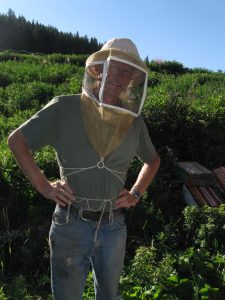
Ed Colby
Get On Board!
coloradobees1@gmail.com
By: Ed Colby
Can’t Find The Time
I don’t know if I’ve successfully managed to “let go” of my honey bee obsession, or if the little darlings have simply buried me. I suspect the latter.
I don’t really have any competing interests. It’s not like I got the apples or the grapes pruned here on the farm, or planted a garden. I used to, but either the gal Marilyn does that stuff, or it doesn’t get done. I never go fishing anymore.
My queens arrived in three shipments of 30 each, from early April until early May. I split my hives and place a new queen in each queen-less split, or I pull four or five-frames out of a hive, put them in a box with a new queen, and call it a nuc. That’s how I use up 90 queens on 125 colonies. Only rarely do I re-queen colonies that already have one. Established two, three and four-year-old queens work fine for me. I let ‘em do their thing. That might not be the best way to keep bees, but it’s my way.
So, 125 hives, 90 new queens that go into splits or nucs. That’s over 200 Spring colonies, and a lot of new blood. The splits hopefully grow up to be double-deep hives with lots of honey supers stacked on top. The nucs generally get put into queen-less colonies.
Once your nucs are queen-right and prospering, you can periodically remove bees and brood to keep these mini-hives from getting too crowded and swarming. That way you have a supply of easily transported queen-right colonies that you can use to introduce a queen into a hive that needs one. I don’t use newspaper or fret about queen acceptance. A nuc inserted into the middle of a queen-less hive works like magic.
Splitting hives and pulling nucs out of established hives is a strong disincentive to Spring swarming. Once crowded bees start filling the brood chamber with honey, in other words, putting honey into the normally empty cells in which the queen lays her eggs, swarming’s probably unstoppable, and that’s my problem here in the merry month of May.
Splitting double-deep hives is a lot of work. I shake the bees from upper box hive down into the lower one, put a queen excluder on top of that lower box, and then put the top super (the one I shook all the bees off of) on top of that. That way, when the bees re-populate that top super through the queen excluder, I’m confident that the queen remains downstairs, and I can take the top super to a different location and put a new queen in it. Are you with me?
Bees hate it when you do this, and if you have any cranky colonies, they’ll express their displeasure in a dramatic way.
Making nucs is a little easier, and it’s less disruptive to the bees. I simply look for the queen on each frame of honey, brood, and bees as I pull it out of the mother hive and put it in my nuc box. If there are a lot of bees on a frame, I’ll look again again after shaking them into a cardboard box. Then I dump those bees into the nuc box. Do I mess up occasionally and put the old queen in the nuc box? Of course. She’ll probably kill the newly introduced queen, and the queen-less mother hive will just have to make a new queen. This is not the end of the world.
I have to get after it, because 30 queens won’t live indefinitely in a shipping box. I could put the little darlings in a queen bank, i.e. a queenless colony of bees, but I hardly ever do this. If I give them food and, more importantly, water, they’ll last a week or two in the box.
We had hot weather and a wicked dandelion honey flow right when I got tied up making the last of my splits. I’d already gotten a second (empty) deep super on my earlier splits, but the bees filled those up in no time flat. Pretty soon they needed honey supers. Where was the beekeeper? At another yard making splits. I didn’t get my honey supers on in time, and now I’ve got swarm cells. How many? I don’t want to think about it.
I know better, and it still happened. But it always stuns me how fast things change. One day you’re feeding bees, and the next they’re getting ready to swarm.
My pal Frank is a meticulous individual who cannot comprehend how I function in such chaos. He sometimes helps me move bees, so he knows how I operate. A retired cabinetmaker who takes pride in his attention to detail, he looks at my beekeeping operation and shakes his head.
I look at it this way. I could maintain 50 hives and probably stay on top of everything. I could even give them a fresh coat of paint. But I wouldn’t make any money. Social Security plus 100 to 200 colonies pays my bills, even when things go wrong. So what if 20 or 30 hives swarm? I wish they wouldn’t, but they do generally re-queen themselves and sometimes even make a honey surplus. If they bounce back, I can send them to California for the almonds. So what’s the problem?
Frank and I go way back. We’re in the Autumn of our years. Like queens in a box, we won’t last forever. He lives to fish. I’d like to go with him, but I can’t find the time. That’s my real problem.
Ed Colby practices beekeeping in Aspen Mountain, Colorado, where he lives with his partner, Marilyn.









